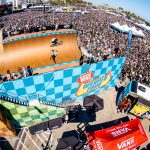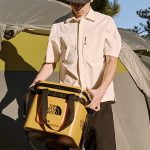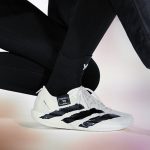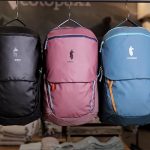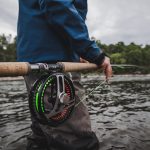Amer Sports, the parent of Wilson, Salomon, Arc-Teryx and other sports brands, filed for a long-expected U.S. initial public offering on Thursday. In its prospectus, Amer touted the benefits of its “Transformation” program following its 2019 acquisition by a China-based Anta Sports-led investors group that has led to a brand-direct model, rapid owned store expansion, and accelerated growth in China.
In its IPO filing, Amer described its purpose as: “Elevating the world through sport—from courts to slopes, from cities to mountains, and everywhere in between, we aim to inspire people to explore and experience the joy of sports and outdoor activities and lead better, healthier lives. Our vision is to be the global leader in premium sports and outdoor brands.”
Amer operates through three reportable segments:
- Technical Apparel: Arc-Teryx and Peak Performance, the Swedish outerwear and streetwear brand;
- Outdoor Performance: Salomon; Atomic, the Austrian ski brand; Armada, the U.S. ski brand; and ENVE Composites, a manufacturer of carbon fiber bicycle rims and components; and,
- Ball & Racquet Sports: Wilson; Louisville Slugger and DeMarini, both U.S.-based makers of baseball bats; Sports Tracker, a fitness tracking app; and Luxilon, a maker of strings for racquet sports.
“Our brands are our stars, constantly elevating the consumer experience and creating thriving communities,” said Amer in its prospectus. “We empower our brands to pursue market-shaping leadership and set the standard for quality, performance and brand experience globally. While our brands have established heritage and market leadership today, significant runway remains ahead.”
The prospectus highlighted Amer’s commitment to sustainability but particularly detailed the continuing payback of its Transformation plan launched in 2019 which has resulted in strong revenue growth, gross margin improvement and increased operating profitability.
As part of the Transformation program, Amer reorganized and simplified its corporate structure to reflect a brand-direct model within its three core segments designed to empower brand managers and support accountability. Each segment is led by one of its top three brands. Amer wrote in the prospectus, “Under this new structure, the leadership team of each brand is responsible for developing its own brand strategy and executing it end-to-end throughout the value chain.”
At the same time, Amer said it has “sharpened our strategic focus on the most attractive subsectors in outdoor and sports, driving our multi-channel strategy and the dominance of our core brands in large markets. We mobilize global resources of the Amer Sports platform to support our brands to create a differentiated and powerful growth engine. Since our transition to our new group structure and operating model, our brands have demonstrated strong momentum and accelerated growth.”
Amer also sought to elevate each brand’s positioning through insights studies and employing a brand-direct model, including more of a direct-to-consumer focus. Amer said the focus has “allowed us to elevate brand positioning and customize each brand’s go-to-market strategies to develop deeper and more meaningful relationships with consumers.”
Amer said these tailored go-to-market strategies are driving traffic and conversion. For example, Arc’teryx’s DTC-channel strategy leverages its positioning in technical apparel that can deliver an “immersive experience” in its stores. Salomon and Wilson are also historically wholesale-driven businesses but are seen as having opportunities to connect with consumers directly. Amer said, “Both brands have recently increased their presence within the DTC channel while enhancing their wholesale partnerships to further brand equity and drive growth.”
As of September 30, Amer’s owned retail network includes 138 Arc’teryx stores, 114 Salomon stores and nine Wilson stores.
Another focus of the Transformation plan has been accelerating brand penetration in Anta’s home market in China.
“We have leveraged key learnings from our long-term oriented owners to enhance our capabilities and performance in Greater China,” Amer said. “As a result, we have grown our Greater China business significantly at a time when others were facing challenges or retrenching. We now have a deep understanding of the average consumer in Greater China and can deliver authentic, technical and premium products that align with consumer preferences.”
Amer said its growth in China has benefited from improved in-store presentation as well as its ability to secure “highly attractive” store locations. As an example, Amer now has 63 Arc’teryx-owned stores in Greater China as of September 30. Amer said, “The stores combined with our brand connect well with both pure outdoor adventurers and luxury consumers in Greater China.”
Also as of September 30, Salomon has 30 owned retail stores and a total of 67 distribution points (including owned retail stores and partner stores). Wilson’s growth in China is benefiting from its recent deal to become the exclusive NBA provider and licensee of basketballs while the “rapid adoption of winter sports” is driving Salomon and Atomic winter equipment sales in China. As a result of those investments, sales in China have grown from 8.3 percent of sales in 2020 to 14.8 percent, or $523.8 million, in 2022. In the first nine months of the current year, China made up 19.4 percent of Amer’s sales. Amer said, “We believe there is significant runway for growth in the region as we continue to roll out retail locations across our brands and scale our e-commerce platform.”
Finally, Amer said it has assembled a “talented and innovative leadership team” to drive growth and execute the Transformation strategy. In 2020, James Zheng, who was also president of Anta Sports until 2023, was appointed CEO. Other key hires have included Michael Hauge Sørensen as COO; Andrew Page as CFO; and Victor Chen as chief strategy officer. At the brand level, Stuart Haselden was appointed to lead Arc’teryx and Peak Performance; Franco Fogliato was hired to guide Salomon; and Joseph Dudy was promoted to lead Wilson. John Yao, who previously helped lead Nike’s business in China for over 17 years, was hired as general manager of Amer Sports Greater China.
As part of the transformation, Amer also exited some non-core assets, leading to the divestiture of Mavic in 2019, Precor in 2021 and Suunto in 2022. Amer said, “We are focused on core brands within our segments which have large market opportunities and significant upside potential, and we have allocated our capital and resources accordingly to achieve our strategic growth plan.”
Comparing 2022 and 2020, revenues increased from $2.4 billion to $3.5 billion, representing a CAGR (compound annual growth rate) of 20.4 percent. Gross margins improved from 47.0 percent to 49.7 percent over those two years. Net losses after non-recurring items increased from $237.2 million to $252.7 million. However, on an adjusted basis, EBITDA grew from $311.4 million to $453.0 million, representing a CAGR of 20.6 percent.
In the nine months ended September 30, revenue increased 29.9 percent to $3.1 billion from $2.4 billion. The gains were primarily driven by an increase in consumer demand in the Technical Apparel segment as Greater China re-opened following the COVID-19 lockdowns in 2022, as well as increased sales in the Outdoor Performance segment as product supply normalized following the pandemic. Revenue on a constant currency basis for the nine months jumped 32.1 percent.
By channel, revenue generated by wholesale for the nine months increased 19.9 percent to $2,051.1 million, primarily driven by increased sales volume in the Technical Apparel and Outdoor Performance segments due to supply chain recovery which allowed retailers to accelerate re-stocking. Revenue generated by the DTC channel jumped 56.7 percent, to $1,002.3 million, primarily driven by an increase in consumer demand in North America and Greater China and a net opening of 33 owned retail stores.
By geography, revenue increased across all geographic regions in the nine months. The Americas grew 19.3 percent to $1,226.4 million, driven mainly by Technical Apparel and DTC channel growth. Greater China grew 67.6 percent to $593.0 million, driven by increased consumer demand following the COVID-19 lockdowns in 2022, mainly in the Technical Apparel and Outdoor Performance segments.
Revenue in EMEA climbed 22.6 percent to $998.5 million, driven by improved sales in the Outdoor Performance segment through the wholesale channel. Revenue in Asia Pacific (excluding Greater China) grew by $81.4 million or 52.8 percent to $235.4 million, driven by increased sales volume in the Technical Apparel segment due to supply chain recovery which allowed retailers to accelerate re-stocking.
Gross margins in the nine months expanded to 52.2 percent from 49.4 percent a year ago. Net losses increased from $104.4 million to $113.9 million, but adjusted EBITDA vaulted 61.3 percent to $422.1 million from $261.8 million.
The filing has been rumored for more than a year. In December 2022, Bloomberg first reported that Anta, headquartered in Jinjiang, was holding preliminary talks with investment banks for an IPO of Amer Sports that could raise about $1 billion or more. Last September, Bloomberg reported that Amer had filed confidentially for an IPO that could value the group as high as $10 billion.
The number of shares to be offered and the price range for the proposed offering have not yet been determined, according to the prospectus. Amer intends to use the proceeds of any transaction to pay off outstanding shareholder loans.
Goldman Sachs, Bank of America, JPMorgan Chase & Co., and Morgan Stanley have been selected as lead managers of the share sale. Amer Sports has applied to list its shares on the New York Stock Exchange under the symbol “AS.”
The filing shows that at the end of 2022, the company had net debt of $5.8 billion. Founded in Finland in 1950, Amer Sports has more than 10,800 employees globally, and offices in Helsinki, Munich, Krakow and Shanghai
Amer went private in 2019 after a consortium led by China’s Anta Sports (2020.HK) acquired it in a deal that valued it at €4.6 billion (U.S.$5.23 billion). Shares had traded on the Nasdaq Helsinki exchange.
Other investors in Anta’s consortium include Canada’s Anamered Investments, private-equity firm FountainVest Partners, and Chinese conglomerate Tencent Holdings, Ltd. Anamered Investments is owned by billionaire Chip Wilson, founder of Lululemon Athletica. Wilson has been nominated to sit on its board in connection with the IPO, the filing showed.
Anta, the majority shareholder with a 53 percent stake, acquired Amer as part of an effort to bring high-end athletic equipment to China’s increasingly wealthy middle class. As part of the joint-ownership structure, Amer remains a separate business entity, but Anta provides R&D and production resources to support expansion in the Chinese market. Amer has its own Board of Directors.
Anta Sports, based in the southern Chinese province of Fujian, last year overtook Adidas as the second-bigger sportswear retailer in China by sales, with revenue of $7.8 billion.
Image courtesy of Salomon
Additional Amer Sports and Anta Sports coverage from SGB Media can be found below.



